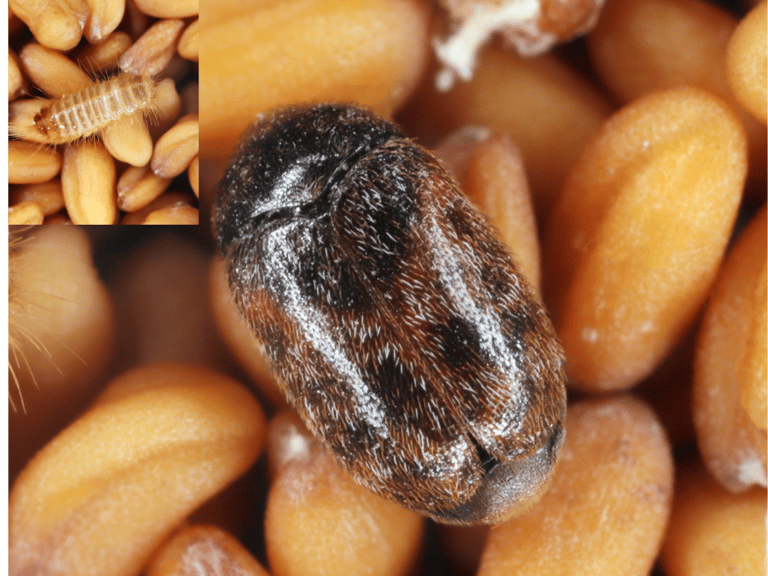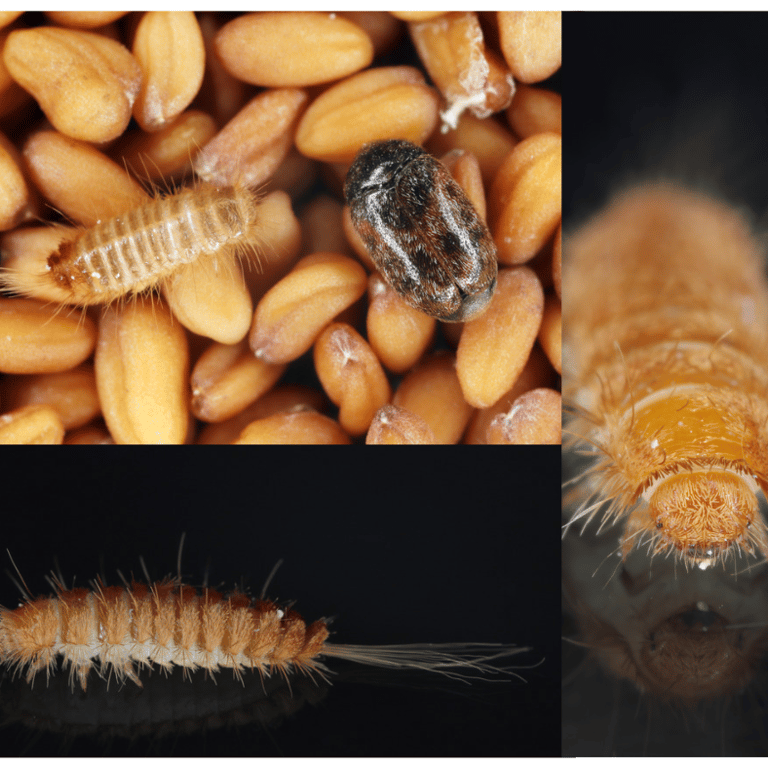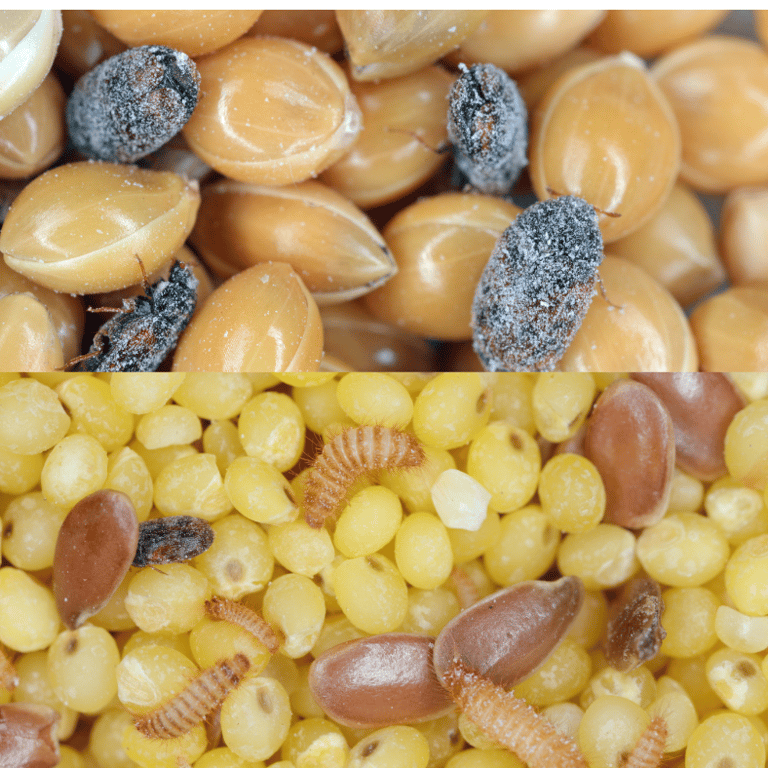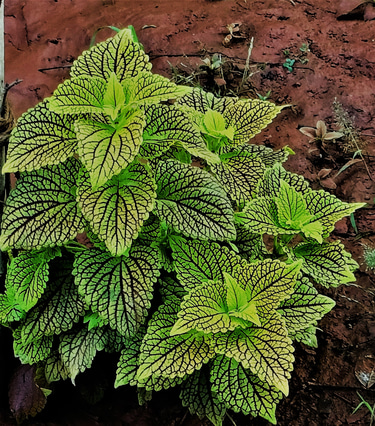The Khapra Beetle, A storage Pest
Infestation of the khapra beetle not only leads to loss in quantity but also in quality aspects like taste , nutrition and merchantability. If grains are stored for of seeds, leads to loss in terms of quantity as well as viability. Thus the khapra are dreaded insect pest may pose grater threat to food security if detected and eradicated in early stages itself.
3/23/20244 min read


Crop cultivation is more of a drudgery which involves a lot of hardships and uncertainty from the stage of sowing to harvest. Then comes post harvest stage, where cultivators have the task of storing their produce by keeping the quantity and quality intact till it is sold. Task and challenges are similar to those take up grain storage as an enterprises or persons involved in bulk grain storage under government agencies. Storage of food grains like wheat, rice, maize, pulses and oil seeds is utmost important as production is seasonal, but to be consumed throughout the year. As per the estimates, insect pests are more intimidating to food products in storage and may cause losses up to 10 to 20 % . The Khapra, a dermestid beetle, is one such insect, management of which is a daunting task. It has been enlisted as quarantine insect by the European and Mediterranean Plant Protection Organization (EPPO) and others, posing challenge to international food grain trade. Currently, distribution of khapra beetle noticed in south east and African countries and some part of Europe. Interception of Khapra has been increased in recent years even in those countries regulations are stringent.
Infestation of the khapra beetle not only leads to loss in quantity but also in quality aspects like taste , nutrition and merchantability. If grains are stored for seeds, leads to loss in terms of quantity and viability as well. Thus the khapra are dreaded insect pest may pose grater threat to food security if not detected and eradicated in early stages itself.
The Khapra beetles, belong to family Dermestidae insect order Coleoptera. These are devastating to stored agriculture product like cereals, oil seeds and pulses. They prefer feeding on food stuffs with low moisture content. It has been discovered that they prefer feed on barley and wheat over rice or maize. These are the pests of warmer areas like Indian Sub- continents and countries of Mediterranean and Africa.
Why does the Khapra beetle devastating ?
Khapra, the winged, but flightless beetles, have certain advantages of its own to overcome extremely adverse situations. Infestations of these beetles in granary, silos, grain storage godowns in dry and hot areas difficult task. Area with severe winter followed by hot summer also preferred by insects. Along with the food grains, they infests food stuffs like almonds, walnuts, dairy products, floors, biscuits, breads, dried meals, dried coconuts. Sometimes other than food items like dead animal matters, tree barks, feathers and nest of birds, hairs, linens, wool, cotton, jute also become sources of infestations. The beetles have ability to complete as many as ten generation in a year if congenial condition prevails. If not take few years to complete one cycle. Adult have the life span of few weeks, but the grubs may undergo multiple instar before transformed into pupa. Grubs are voracious feeders in the presence of abundant food and climatic conditions are favoring. The juveniles undergo diapause if they are over populated and foods stuffs are dearth and climatic conditions are not favoring. Even they survive in the absence of food for years together by the mechanism of dormancy. Going to dormancy and attaining active stage happens intermittently and repeatedly and the same delays pupal stage. Molting and casting of skins is a continuous process whether grubs are active or dormant. They are able reduce their size by molting and shedding the skins to hide in the cracks and cervices during non availability of food (Beck, 1971).
Life cycle of Khapra beetles
Adult khapra are short lived, tiny, round or oval shaped, measuring 2-3mm in length. Male adults are dark brown or black where as female are of light brown and slightly larger in size. . Females lay minute eggs, creamy white or pale yellowish in color and cylindrical in shape and are round on one end and pointed at the other. Grubs are of length 5-6mm, covered with stuff of hairs all over the body, hairs at posterior end taller, resembling a tail. Grubs are reddish at initial instars and turns golden brown later. The life cycle of Khapra beetles largely depends on Temperature and relative humidity prevail in storage unit or surrounding the food stuff stored.
They become active when there is considerable increase in temperature and availability of food (Nair and Desai, 1973). In the availability of food and temperature 30-35 °C and relative humidity 50-60% these beetle become devastating.


Management of Khapra beetles:
It is well known fact that an established Khapra beetles infestation very difficult to manage and an up hill task to eradicate. Thus the insect pest has to be administered initial stages itself. Presence of castings, skin and dead and dormant insects thoroughly checked at cracks and crevices, baggage materials, containers and carriers, and surroundings of food storage structures and units. Area or units where packing materials like jute bags, cardboard boxes, and any other are stored, to be thoroughly checked for infestation and dis-infested regularly.
The beetles are flightless as such, but movement and spread is mainly from infested consignments or through infested carriers, containers and packing materials. At the same time, insects are to be properly identified, as khapra grubs and adults looks similar to other Dermestid members which are less harmful and easy to manage. Being more cautious is very essential at the season when congenial climate prevails for the surge of khapra.
Care should be taken to avoid storing of freshly harvested grains with previous or old stuffs. Cracks and crevices on the flour and walls of the godowns to be arrested to avoid insect hideouts and success of dis-infestation measures.
It is very essential to keep the surrounding of storage structure free from plants, weeds, grasses and any other kind of debris. Storage units are to be maintained hygienically with regular sweeping and collection of spilled grains. It is advised to dispose the spillages contaminated with grubs, debris , dead insects, skins and castings.
Chemically, fumigation with phosphine gas, spraying with Malathion or any kind of Pyrehroids are popular. Fumigation followed by surface treatment with malathion or Deltamethrin have been found fruitful. While taking up of fumigation care has to be taken to make the fumigated area airtight. Flour of storage units should be free from cracks and crevices to avoid diffusion of phosphine gas which may make process of fumigation futile or less effective. As per some study, grubs under hibernation are less susceptible to fumigation if the temperature inside the godown less than 25oC.
Heat treatment for 30 minute at 60oC for 30 minutes or at 42.5oC for 8 days have been found effective and Eco-friendly measures. At small scale or household storage, food grains are mixed with neem powder is reported to be effective in keeping the khapra beetles away.
Newsletter
Sign up for our newsletter and get notified about all new posted articles.
ADDRESS
House No. 2-113(P), Visnumurthynagar, Kelarkalabettu, Thenkanidiyuru, Udupi
cONTACT
7975809540
satishmqc362@gmail.com
